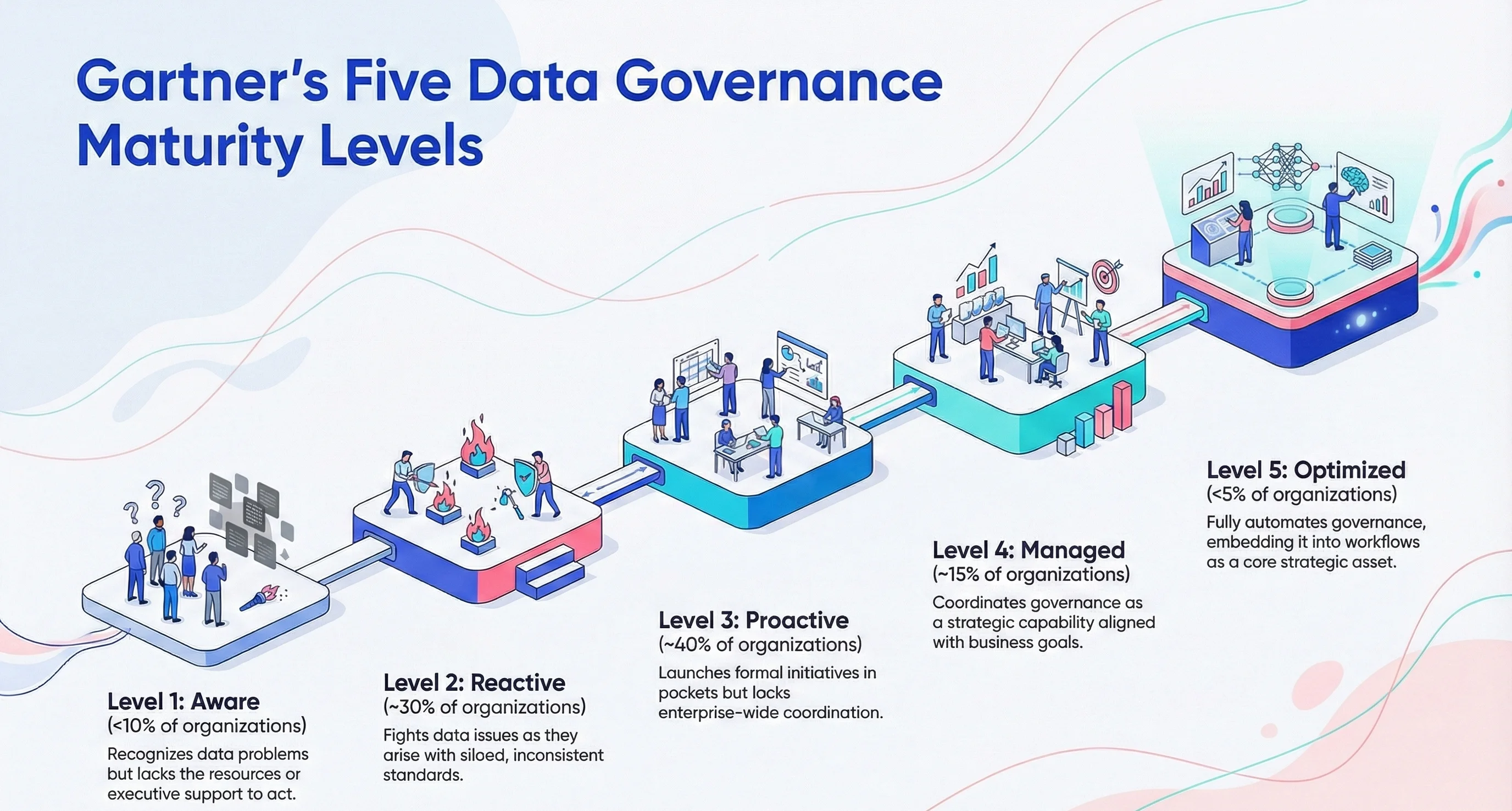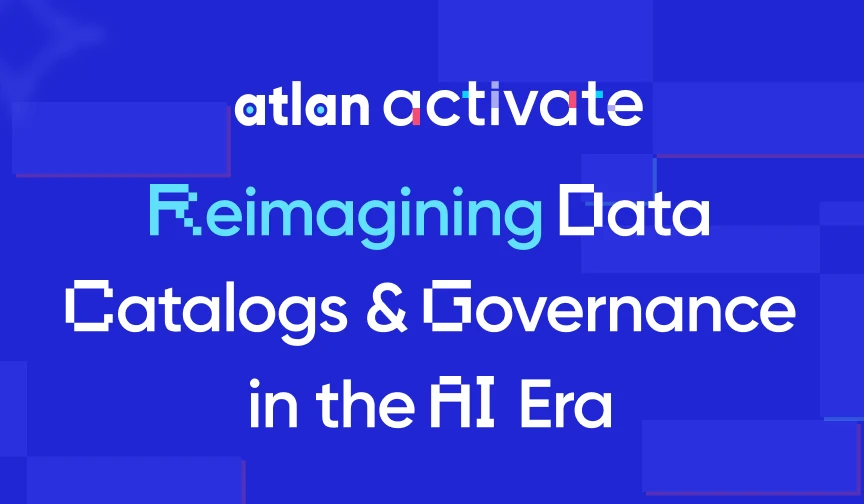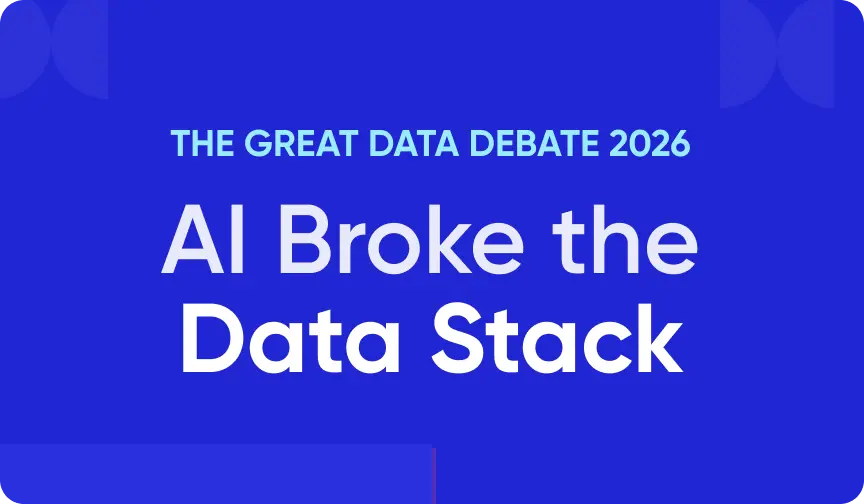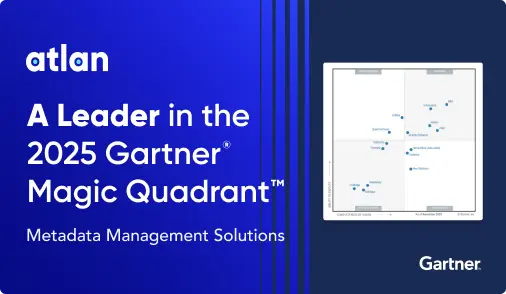Gartner Data Governance Maturity Model: What It Is and How to Use It
What is the Gartner data governance maturity model?
Permalink to “What is the Gartner data governance maturity model?”The Gartner data governance maturity model is a structured framework that organizations use to evaluate and improve their enterprise information management capabilities. First introduced in 2008, the model provides a systematic way to assess how well organizations manage, govern, and extract value from their data assets.
Gartner positions data governance maturity as a critical component of their broader Enterprise Information Management (EIM) Maturity Model. The maturity assessment helps organizations understand where they stand and what needs to change.
Seven foundational building blocks
Permalink to “Seven foundational building blocks”The Gartner data governance maturity model evaluates organizations across seven interconnected dimensions:
- Vision: Clear understanding of information as a strategic asset.
- Strategy: Formal plans for managing information across the enterprise.
- Metrics: Measurable indicators of information management effectiveness.
- Information governance: Policies, standards, and oversight mechanisms.
- Organization and roles: Defined responsibilities and accountability structures.
- Information lifecycle: Processes for managing data from creation to retirement.
- Infrastructure enablement: Technology platforms and tools supporting governance.
Modern data catalogs approach these building blocks through automation rather than manual documentation. These platforms can automatically discover assets, track lineage, and enforce policies without requiring extensive upfront configuration.
This shifts organizations from reactive firefighting to proactive governance embedded in daily workflows.
Why maturity assessment matters
Permalink to “Why maturity assessment matters”Understanding your current maturity level provides three critical benefits:
- Create a shared language for discussing governance challenges across technical and business stakeholders.
- Prioritize investments by identifying the highest-impact improvements for your current stage.
- Get benchmarks for measuring progress over time and demonstrating value to executive sponsors.
Organizations at different maturity levels face fundamentally different challenges. For example, a level 2 organization struggling with data silos needs different solutions than a level 4 organization working to optimize automated workflows. The maturity model helps teams focus on the right problems at the right time.
Gartner’s five data governance maturity levels explained
Permalink to “Gartner’s five data governance maturity levels explained”Gartner’s maturity model organizes organizations into five distinct levels, each representing increasing sophistication in how they manage and govern information assets.
According to Gartner research, organizations distribute across these levels with most clustering in the middle stages.
1. Level 1: Aware (less than 10% of organizations)
Permalink to “1. Level 1: Aware (less than 10% of organizations)”Organizations at the Aware level recognize they have data quality and governance problems but lack the resources or executive support to address them systematically.
Awareness often emerges after a compliance violation, data breach, or high-profile data quality incident exposing governance gaps. However, without budget, leadership sponsorship, or clear accountability, organizations remain stuck identifying problems without solving them.
2. Level 2: Reactive (approximately 30% of organizations)
Permalink to “2. Level 2: Reactive (approximately 30% of organizations)”Reactive organizations respond to governance challenges as they arise rather than preventing them proactively. Guidelines exist for managing data quality, classification, and security, but these standards live in silos.
Moreover, teams feel empowered to bypass guidelines when convenient, and there’s minimal systematic support for addressing root causes of data quality issues.
Data governance at this stage follows a firefighting model. For instance, a data breach triggers new security policies. A failed analytics project prompts data quality reviews.
While better than doing nothing, this reactive approach leaves organizations vulnerable to repeated incidents and persistent data trust issues.

Gartner data governance maturity model Infographic. Source: Atlan.
3. Level 3: Proactive (approximately 40% of organizations)
Permalink to “3. Level 3: Proactive (approximately 40% of organizations)”Proactive organizations intentionally launch initiatives to improve governance practices. Data stewards are assigned to monitor quality and enforce policies. Metadata management becomes operational, providing context about data origins, usage, quality, and purpose.
The critical limitation at level 3 is scope. Governance efforts target high-priority data sets and critical systems rather than spanning the entire enterprise. So, progress happens in pockets rather than organization-wide.
Organizations at this stage often see competing governance initiatives across departments. Engineering implements one data catalog, finance deploys another, and neither integrates with existing systems. Larger cross-team initiatives begin emerging but lack coordination.
4. Level 4: Managed (approximately 15% of organizations)
Permalink to “4. Level 4: Managed (approximately 15% of organizations)”Organizations reach level 4 when they coordinate governance across two or more enterprise-wide initiatives. Policies evolve from scattered guidelines into documented principles and automated procedures. Clear roles and responsibilities exist with defined accountability.
The shift from level 3 to level 4 represents a fundamental change in how governance operates. Improvements are driven by business objectives rather than technical needs. Governance becomes a strategic capability rather than a compliance checkbox.
Managed organizations typically have established governance councils, formalized stewardship programs, and integrated technology platforms powered by automation and AI. They measure governance effectiveness through business metrics like decision cycle time and analytics adoption rather than just compliance indicators.
5. Level 5: Optimized (less than 5% of organizations)
Permalink to “5. Level 5: Optimized (less than 5% of organizations)”Optimized organizations have fully automated information asset management systems that catalog all data that matters to the business. Creating high-quality, governed, and secured data is embedded into everyone’s daily workflow processes.
At this level, active metadata connects previously siloed systems and enables discovery of previously unknown data assets. Policy enforcement happens automatically without manual intervention. The organization treats data as a vital strategic asset with continuous improvement processes aligned to evolving business needs.
Very few organizations operate at level 5 consistently across their entire data estate. Most maintain pockets of optimized governance around mission-critical data while continuing to mature other domains.
What are the seven building blocks of enterprise information management?
Permalink to “What are the seven building blocks of enterprise information management?”Gartner’s maturity model evaluates each organization across seven foundational dimensions that collectively determine overall maturity. Understanding these building blocks helps organizations identify specific areas requiring investment and improvement.
1. Vision and strategic alignment
Permalink to “1. Vision and strategic alignment”Vision represents how clearly an organization understands information as a strategic asset rather than a technical byproduct. Mature organizations articulate specific business outcomes enabled by governed data. Early-stage organizations view governance as a compliance obligation disconnected from business value.
The vision building block answers fundamental questions, such as:
- What business problems does governance solve?
- Which stakeholders benefit from improved data management?
- How does governance enable competitive advantage?
2. Strategy and roadmap
Permalink to “2. Strategy and roadmap”Strategy translates vision into concrete plans for managing information across the enterprise. This includes picking high-priority domains, investing in the right technology, and making organization-wide changes.
That’s where a data governance framework can help, by providing the strategic foundation for consistent decision-making about data ownership, quality standards, and access controls.
Mature organizations maintain living roadmaps that evolve based on business priorities rather than rigid multi-year plans.
3. Metrics and measurement
Permalink to “3. Metrics and measurement”Metrics enable organizations to assess governance effectiveness objectively and demonstrate business value.
Early-stage organizations lack governance metrics entirely, making it impossible to measure progress or justify investment. Mature organizations track both operational metrics (data quality scores, policy compliance rates) and business metrics (decision cycle time, analytics adoption, revenue impact).
4. Governance policies and standards
Permalink to “4. Governance policies and standards”Data governance encompasses the policies, standards, and oversight mechanisms that guide data management decisions. This includes data classification schemes, quality standards, retention policies, and access control frameworks.
Mature organizations automate policy enforcement through technology platforms rather than relying on manual compliance checks.
Modern governance platforms can help by generating policies from natural language descriptions and enforce them automatically across distributed data systems.
So, when a new data source is discovered, classification policies tag sensitive fields, quality policies flag anomalies, and access policies restrict visibility based on defined roles.
5. Organization structure and roles
Permalink to “5. Organization structure and roles”Clear roles and accountability structures are essential for sustained governance. The building block evaluates whether organizations have defined positions like data stewards, data owners, and governance councils with documented responsibilities and authority to make decisions.
Mature organizations adopt federated models where domain teams own their data while adhering to enterprise standards. This balances the need for local autonomy with requirements for consistency and interoperability.
6. Information lifecycle management
Permalink to “6. Information lifecycle management”Information lifecycle management addresses how data is created, stored, used, archived, and eventually deleted according to defined policies. This includes data retention requirements, archival procedures, and disposal processes aligned with regulatory obligations and business needs.
Organizations at early maturity stages lack systematic lifecycle management, leading to excessive storage costs and compliance risks from retained data that should have been deleted.
Mature organizations automate lifecycle processes based on metadata tags and policy rules.
7. Infrastructure and technology enablement
Permalink to “7. Infrastructure and technology enablement”The infrastructure building block evaluates the technology platforms and tools supporting governance activities. This includes data catalogs, quality management systems, access control mechanisms, and integration platforms. Mature organizations leverage automation and active metadata to reduce manual governance overhead.
It’s important to note that technology alone cannot create governance maturity, but appropriate tooling dramatically accelerates progress.
Modern platforms like Atlan automate discovery, classification, lineage tracking, and quality monitoring that would otherwise require extensive manual effort. This frees teams to focus on strategic governance challenges rather than operational maintenance.
How to assess your current maturity level: A step-by-step guide
Permalink to “How to assess your current maturity level: A step-by-step guide”Conducting an accurate maturity assessment requires systematic evaluation across all seven building blocks rather than relying on subjective impressions. Organizations often overestimate their maturity by focusing on pockets of strength while overlooking systemic weaknesses.
Step 1: Choose an assessment methodology
Permalink to “Step 1: Choose an assessment methodology”Your assessment methodology should be comprehensive, so make sure you cover the following:
- Begin with stakeholder interviews across business and technical functions (data owners, stewards, consumers, etc.) to understand current practices and pain points.
- Ask about decision-making processes, data quality experiences, and governance obstacles they encounter.
- Document existing governance artifacts like policies, standards, procedures, and organizational charts.
- Review technology infrastructure including catalogs, quality tools, and access control systems.
- Analyze metadata availability and quality for representative data assets.
- Assess automation levels for discovery, classification, lineage, and policy enforcement.
Step 2: Develop diagnostic questions by dimension
Permalink to “Step 2: Develop diagnostic questions by dimension”For each of the seven building blocks, assess capabilities against maturity level characteristics:
Vision questions:
- Can stakeholders articulate business outcomes enabled by data governance?
- Does executive leadership actively sponsor governance initiatives?
- Is governance viewed as strategic enablement or compliance overhead?
Strategy questions:
- Does a documented governance roadmap exist with clear priorities?
- Are resources allocated to execute the strategy?
- Does the strategy balance quick wins with long-term capability building?
Metrics questions:
- Are governance effectiveness metrics tracked and reported?
- Do metrics link governance activities to business outcomes?
- Are metrics used to guide continuous improvement decisions?
Governance questions:
- Are policies documented, communicated, and consistently enforced?
- How much policy enforcement is automated versus manual?
- Can governance scale with business growth and new data sources?
Organization questions:
- Are data ownership and stewardship roles clearly defined?
- Do people have authority to make governance decisions?
- Is governance centralized, federated, or decentralized?
Lifecycle questions:
- Are retention and disposal policies implemented systematically?
- How are data quality issues identified and remediated?
- Is data lineage tracked from source to consumption?
Infrastructure questions:
- What governance capabilities are automated versus manual?
- How quickly can new data sources be discovered and governed?
- Do tools integrate or create additional silos?
Step 3: Conduct gap analysis and pick your priorities
Permalink to “Step 3: Conduct gap analysis and pick your priorities”Compare current state assessments against desired target state for your organization. Not every organization needs to reach level 5 across all dimensions. A level 4 organization might be perfectly positioned to achieve its business objectives.
Identify gaps between current and target state. Prioritize improvements based on business impact and feasibility. Quick wins help in demonstrating value, building momentum and securing ongoing investment.
Organizations can accelerate assessment through maturity evaluation tools that provide structured questionnaires and benchmark comparisons. These tools help identify blind spots and provide concrete improvement recommendations based on your specific situation.
Use this 5-minute readiness checker as a baseline to assess your data governance maturity and plan your optimization strategy
Take the Assessment →How can you progress through Gartner’s data governance maturity stages?
Permalink to “How can you progress through Gartner’s data governance maturity stages?”Moving from one maturity level to the next requires systematic capability building rather than random improvement efforts. Each level transition involves distinct challenges and success factors that organizations should understand before beginning the journey.
From Aware to Reactive: Building initial capabilities
Permalink to “From Aware to Reactive: Building initial capabilities”Organizations stuck at level 1 need executive sponsorship and initial budget allocation before progress is possible. The primary goal is demonstrating value through focused pilots that address visible pain points. Select a critical data domain experiencing quality issues that impact business operations.
Common approaches include implementing basic data quality rules for high-value datasets, establishing a data catalog for key analytics assets, or documenting policies for sensitive data handling.
Success at this stage means moving from talking about governance to actually implementing initial practices, even if limited in scope.
From Reactive to Proactive: Systematic improvement
Permalink to “From Reactive to Proactive: Systematic improvement”The transition from level 2 to level 3 requires shifting from firefighting to prevention. This involves establishing formal stewardship roles, implementing metadata management, and beginning to coordinate governance across teams.
Organizations must move beyond isolated initiatives to intentional programs with defined objectives.
Technology investment becomes important at this stage. Manual governance processes that work for dozens of data assets fail when scaled to thousands. Automated metadata discovery, classification, and lineage tracking become essential.
From Proactive to Managed: Enterprise coordination
Permalink to “From Proactive to Managed: Enterprise coordination”Reaching level 4 requires coordination across multiple domains and initiatives. Governance cannot remain within individual teams or departments. Organizations need enterprise-wide governance councils, integrated technology platforms, and standardized processes that work across diverse data systems.
The critical challenge is balancing consistency with flexibility. Overly rigid governance creates friction and drives shadow IT. Overly flexible governance creates chaos and compliance risks.
From Managed to Optimized: Continuous improvement
Permalink to “From Managed to Optimized: Continuous improvement”Very few organizations consistently operate at level 5. The transition requires embedding governance so deeply into workflows that it becomes invisible to end users.
Here’s what this looks like. Data quality checks happen automatically in pipelines. Access controls adjust dynamically based on data sensitivity and user context. Lineage is maintained in real-time as data flows through systems.
At this level, organizations shift from implementing governance to continuously optimizing it. Machine learning enhances policy recommendations. Active metadata enables proactive issue detection. Governance becomes a competitive advantage rather than a cost center.
Timeline and resource expectations
Permalink to “Timeline and resource expectations”Maturity progression takes time and sustained investment. Moving from level 1 to level 3 typically requires 12-18 months with dedicated resources. Reaching level 4 takes an additional 18-24 months.
Few organizations attempt to reach level 5 across their entire data estate, instead maintaining optimized governance for mission-critical domains.
Resource requirements vary by organization size and complexity. Small organizations might dedicate 2-3 people to governance program management and stewardship. Large enterprises often require teams of 10-20 people for program coordination, policy development, and technology management. Modern platforms with extensive automation can reduce these resource requirements significantly.
How do modern platforms accelerate data governance maturity progression?
Permalink to “How do modern platforms accelerate data governance maturity progression?”Organizations face a fundamental challenge as they progress through maturity levels. Manual governance processes that work for hundreds of data assets break down when scaled to thousands or tens of thousands. Coordination overhead grows exponentially without automation and active metadata capabilities.
Traditional governance approaches required extensive upfront configuration, rigid role structures, and manual maintenance of metadata and policies. Organizations spent months cataloging data before users could search for anything. Policy enforcement relied on periodic audits rather than real-time controls.
Modern data platforms address these scaling challenges through automation, active metadata, and embedded governance that works within existing workflows rather than creating additional process overhead.
Discovery happens automatically as new data sources are added. Classification applies based on content and patterns rather than manual tagging. Lineage tracks data movement in real-time across heterogeneous systems.
The role of automation in improving your organization’s governance maturity
Permalink to “The role of automation in improving your organization’s governance maturity”Atlan’s approach to governance automation directly addresses the progression challenges organizations face at each maturity level.
For organizations at level 2 struggling with reactive firefighting, automated discovery and classification provide immediate visibility into data assets and their sensitivity levels without extensive manual cataloging work.
At level 3, where organizations begin coordinating governance across domains, Atlan’s federated model enables business units to manage their data within enterprise guardrails.
Domain teams assign ownership, document business context, and monitor quality for their assets while central teams maintain visibility and ensure policy compliance. Automated workflows handle routine approval processes, freeing stewards to focus on exceptions and strategic decisions.
Organizations progressing toward level 4 benefit from policy automation that enforces standards consistently across distributed systems. Create data access policies using natural language descriptions. The platform automatically applies them across cloud warehouses, BI tools, and analytics platforms. When policy violations occur, automated alerts enable immediate response rather than discovery months later during an audit.
For organizations approaching level 5, active metadata capabilities enable continuous optimization. The platform monitors actual data usage patterns, identifies high-value assets automatically, and suggests governance improvements based on observed issues. AI-powered documentation keeps descriptions current as data evolves. This reduces maintenance overhead while increasing governance effectiveness.
Organizations using integrated governance platforms report 60% faster policy approval cycles and significantly higher participation rates from business stakeholders. Governance shifts from a technical burden to an enabler of self-service analytics and AI initiatives.
See how Atlan helps organizations progress through maturity levels faster by automating governance at scale.
Real stories from real customers: How future-forward enterprises are improving their data governance maturity
Permalink to “Real stories from real customers: How future-forward enterprises are improving their data governance maturity”
Implemented data governance processes using Atlan
“We worked with a consulting firm that helped map out a data maturity model journey. As part of that it was agreed that setting up a Data Governance program should be one of the first steps. We picked Atlan because of its UI. Within two clicks, people were exactly where they wanted to be.”
Kelsey Coffin, Senior Data Governance Manager
Commonwealth Financial Network
🎧 Listen to podcast: From spreadsheets to Commonwealth’s active metadata strategy

Implemented data governance strategy and roadmap using Atlan
“Our objective was to improve Aliaxis’ maturity around Data Governance, and we wanted to ensure that whatever tool we picked not only fit nicely with our tech stack, but that users didn’t feel intimidated, or felt that it was a huge organizational shift. Atlan’s user-friendliness seemed so simple and its capabilities gave us room to grow and mature as an organization without too many restrictions.”
Nestor Jarquin, Global Data & Analytics Lead
Aliaxis
🎧 Listen to podcast: Aliaxis’s global data journey with Atlan
Ready to reach the next stage of data governance maturity?
Permalink to “Ready to reach the next stage of data governance maturity?”Gartner’s data governance maturity model provides a roadmap for systematic improvement from reactive firefighting to optimized, automated governance.
Most organizations cluster at levels 2-3, with progression to higher maturity requiring sustained investment in people, processes, and technology. The seven building blocks offer a diagnostic framework for identifying specific improvement priorities aligned with business objectives.
Modern platforms accelerate maturity advancement by automating discovery, classification, policy enforcement, and lineage tracking that would otherwise require extensive manual effort.
Atlan supports your maturity progression across all seven governance building blocks.
Let’s help you build it
Book a Personalized Demo →FAQs about the Gartner data governance maturity model
Permalink to “FAQs about the Gartner data governance maturity model”1. What is the Gartner data governance maturity model?
Permalink to “1. What is the Gartner data governance maturity model?”The Gartner data governance maturity model is a five-level framework for assessing enterprise information management capabilities. Organizations progress from Aware (recognizing problems) through Reactive, Proactive, and Managed levels to Optimized (fully automated governance).
The model evaluates seven building blocks including vision, strategy, metrics, governance policies, organizational structure, lifecycle management, and enabling technology. Organizations use it to diagnose current state and prioritize systematic improvements.
2. What are the five maturity levels in the Gartner model?
Permalink to “2. What are the five maturity levels in the Gartner model?”The five levels are Aware (less than 10% of organizations), Reactive (30%), Proactive (40%), Managed (15%), and Optimized (less than 5%).
- Aware organizations recognize problems but lack resources to address them.
- Reactive organizations respond to incidents after they occur.
- Proactive organizations launch intentional improvement initiatives.
- Managed organizations coordinate governance enterprise-wide with documented policies.
- Optimized organizations have fully automated governance embedded in daily workflows.
3. How long does it take to progress through maturity levels?
Permalink to “3. How long does it take to progress through maturity levels?”Moving from level 1 to level 3 typically requires 12-18 months with dedicated resources and executive sponsorship. Reaching level 4 takes an additional 18-24 months of sustained investment.
Timeline varies based on organization size, complexity, and starting conditions. Quick wins within the first 90 days help build momentum and secure ongoing support. Most organizations do not attempt to reach level 5 across their entire data estate.
4. What’s the difference between Gartner’s model and other maturity frameworks?
Permalink to “4. What’s the difference between Gartner’s model and other maturity frameworks?”Gartner’s model focuses specifically on enterprise information management with seven building blocks and five levels.
The IBM model assesses 11 governance disciplines using four stages. DAMA-DMBOK covers 11 knowledge areas with five maturity levels each, providing a more granular assessment. CMMI focuses on process maturity with five levels emphasizing quantitative management.
Organizations should select the framework that best aligns with their governance priorities and organizational context.
5. Can organizations skip maturity levels?
Permalink to “5. Can organizations skip maturity levels?”Organizations cannot sustainably skip maturity levels because each level builds capabilities required for the next stage. A Level 2 organization lacking basic stewardship roles cannot implement level 4 enterprise-wide governance effectively.
However, organizations can accelerate progression through modern platforms that automate capabilities typically requiring manual processes. For example, automated discovery and classification can help organizations move faster from reactive to proactive governance.
6. How does Atlan support organizations at different maturity levels?
Permalink to “6. How does Atlan support organizations at different maturity levels?”Atlan supports progression across all maturity levels through automated discovery, intelligent search, classification, lineage tracking, and policy enforcement.
- Organizations at Level 2 gain immediate visibility into data assets.
- Level 3 organizations coordinate governance across domains through federated models.
- Level 4 organizations automate policy enforcement at scale.
Platform capabilities adapt to organizational needs, providing simple workflows for early maturity while supporting advanced automation for mature programs.
Share this article
Atlan is the next-generation platform for data and AI governance. It is a control plane that stitches together a business's disparate data infrastructure, cataloging and enriching data with business context and security.
Gartner data governance maturity model: Related reads
Permalink to “Gartner data governance maturity model: Related reads”- How to Choose a Data Governance Maturity Model in 2026
- Gartner Data Governance: 2026 Framework, Research & Implementation
- Gartner Magic Quadrant for Data & Analytics Governance Platforms
- Data Governance Framework: Examples, Templates, Best Practices
- Data Governance Readiness Assessment: Questionnaire & Guide
- Data Governance Key Components: Complete Enterprise Guide
- Data Governance Roles and Responsibilities: A Round-Up
- Gartner Active Metadata Management: Trends & Recommendations
- Gartner Magic Quadrant for Metadata Management Solutions 2025
- Data Governance in Action: Community-Centered and Personalized
- Federated Data Governance: Principles, Benefits, Setup
- Enterprise Data Governance: Frameworks and Workflows for Scale
- AI Data Catalog: Exploring the Possibilities That Artificial Intelligence Brings to Your Metadata Applications & Data Interactions
- 7 Top AI Governance Tools Compared | A Complete Roundup for 2026
- Dynamic Metadata Discovery Explained: How It Works, Top Use Cases & Implementation in 2026
- 9 Best Data Lineage Tools: Critical Features, Use Cases & Innovations
- Data Lineage Solutions: Capabilities and 2026 Guidance
- 12 Best Data Catalog Tools in 2026 | A Complete Roundup of Key Capabilities
- Data Catalog Examples | Use Cases Across Industries and Implementation Guide
- 5 Best Data Governance Platforms in 2026 | A Complete Evaluation Guide to Help You Choose
- Data Lineage Tracking | Why It Matters, How It Works & Best Practices for 2026
- Dynamic Metadata Management Explained: Key Aspects, Use Cases & Implementation in 2026
- How Metadata Lakehouse Activates Governance & Drives AI Readiness in 2026
- Metadata Orchestration: How Does It Drive Governance and Trustworthy AI Outcomes in 2026?
- What Is Metadata Analytics & How Does It Work? Concept, Benefits & Use Cases for 2026
- Semantic Layers: The Complete Guide for 2026






















